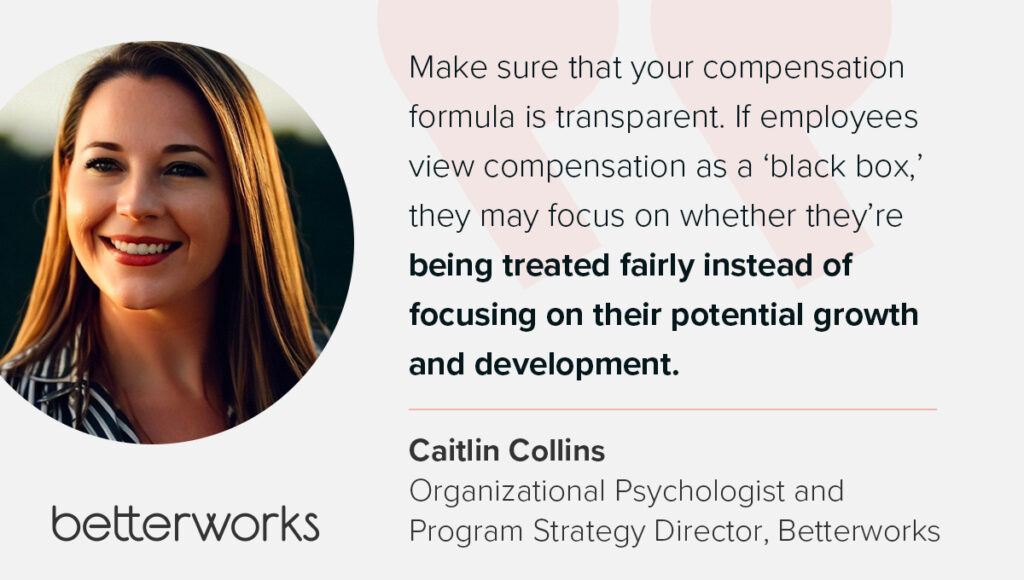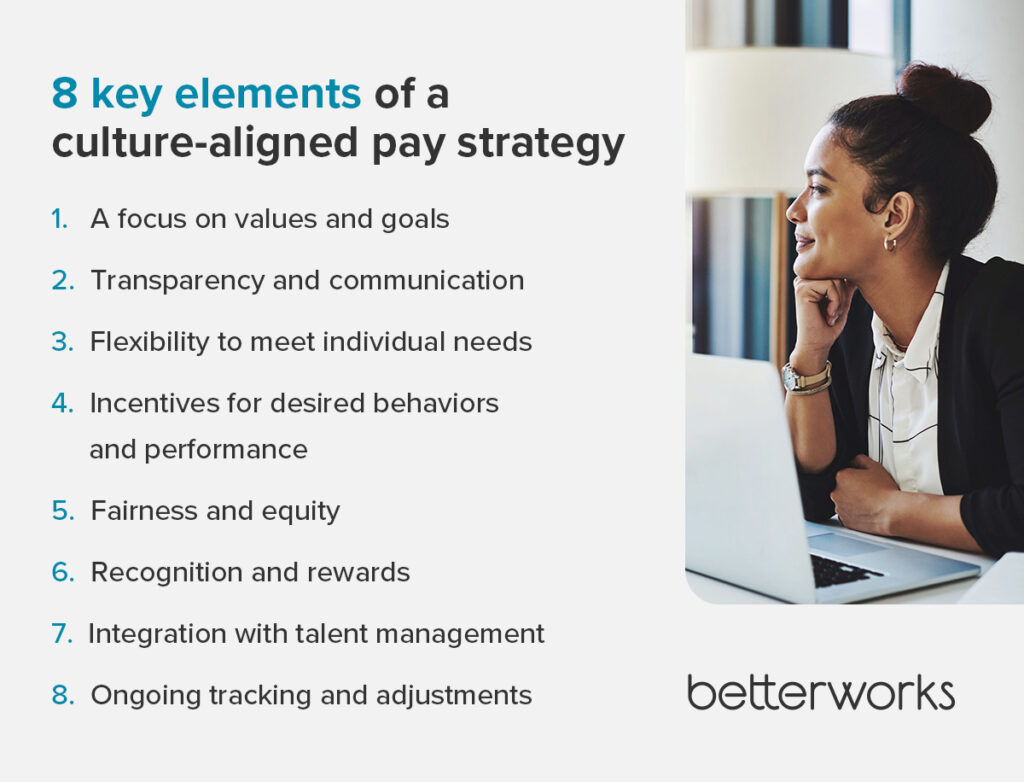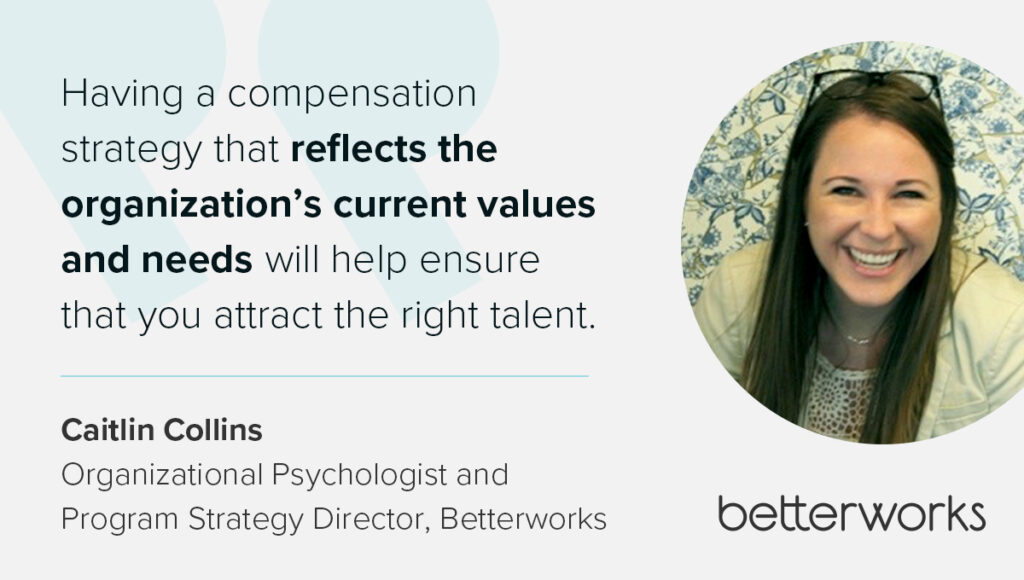Aligning compensation to organizational culture isn’t easy or quick. It requires a thorough understanding of how your existing compensation practices and company culture intersect and a clear vision of what you’d like them to be.
Pay and benefits remain the most common reason that employees quit, according to Gallup research. Compensation and culture are linked because without both being strong, employee engagement will suffer over time — and so will retention. But when compensation strategy aligns with core values, companies perform better and increase employee satisfaction.
Learn more about how to tie compensation to company culture, what alignment looks like, and how you can get started.
The intersection of compensation and culture
Your compensation costs sit in two buckets: wages/salary (70.4% of private-sector employee compensation), and benefits (29.6%). Both areas present opportunities for employers to shape culture, incentivize the right behaviors, and bolster their employer brand.
Strategically designed compensation systems influence employee behaviors in the right ways, which influences your culture and norms. Bonuses and performance-based incentives, for example, show employees which actions are rewarded — and which aren’t.
Benefits, meanwhile, also shape behaviors and company culture. Offering mental health benefits can improve wellness, for example, while a policy that requires a minimum amount of annual vacation can encourage employees to take care of themselves while still excelling at their jobs.
You want your compensation practices to be an expression of company values, rewarding aligned behaviors and achievements. This alignment creates a sense of belonging and purpose among employees and contributes to cultural integration. Ineffective compensation plans, by contrast, create conflict with cultural values, hinder goal achievement, and contribute to turnover.
3 challenges when aligning compensation with culture
Getting a handle on organizational culture can be challenging enough for many organizations. Aligning that culture with a defined compensation plan is a higher level of difficulty. Here are three common challenges you’ll likely encounter while aligning your compensation strategy with your culture.
Overcoming resistance to change
Aligning compensation to organizational culture often means revisiting and revising current compensation practices. Any changes to compensation will affect existing employees, who will notice the differences more than new hires. Understandably, this might surprise some workers, especially if they feel negatively affected by the adjustments.
To overcome resistance and win their buy-in, you need to quickly and consistently apply change management strategies. When people feel informed about changes and believe their voice has been heard, they’re more likely to support the plan.
Communication is key to helping employees embrace change, whether to compensation or anything else. Explain what’s changing, why it’s happening, and how each employee will be affected.
Make sure to get employee feedback throughout the implementation. Simply receiving employee feedback can help people feel heard, even if you don’t make the change they’ve asked for.
Being fair while maintaining flexibility and adaptability
As business needs and cultural dynamics shift, so too should compensation strategies. This flexibility helps organizations navigate rapid changes without losing sight of their cultural values.
Companies that are rapidly growing might focus on recruitment and competitive pay, as they’re hiring quickly. Conversely, more mature companies might emphasize retention and internal mobility. In both cases, the specifics might change, but not the underlying compensation values.
Addressing disparities in employee expectations
One of the most challenging aspects of aligning compensation with culture is managing disparate employee expectations. These differences arise from numerous circumstances, including past compensation, personal and professional backgrounds, and career aspirations.
HR leaders must be fair and equitable when designing compensation strategies, even as they look to personalize compensation packages for individual needs and circumstances. Options include flexible benefits, performance-based bonuses, and career development opportunities. These approaches cater to different employee needs and expectations without creating inequitable or discriminatory conditions that jeopardize your organizational culture.

8 key elements of a culture-aligned pay strategy
Companies can have strong cultures while lacking a sound compensation strategy, and vice versa. As you figure out how to tie compensation to company culture, here are some elements to include.
A focus on values and goals
Your approach to all talent policies, including compensation, should reflect and reinforce the organization’s core values and goals. For example, companies that value teamwork and collaboration might give team performance bonuses or share profits. Such compensation offerings align with the culture because they reward collective success. If transparency is a core value, employees should be able to see what their colleagues earn — and why.
Transparency and communication
Clear communication about your compensation strategy helps reinforce a culture of openness and trust. Employees should understand how their compensation is determined, how it aligns with the organizational culture, and how they can influence it through their behavior and performance.
Flexibility to meet individual needs
A culture-aligned pay strategy recognizes that employees have different needs and preferences. Consider compensation components such as variable pay and flexible benefits that support individual needs while aligning with cultural and organizational objectives.
Incentives for desired behaviors and performance
Your compensation system should include incentives that directly encourage and reward the behaviors and performance outcomes that are most valued by the organization. This might include specific rewards for innovation, customer service excellence, efficiency improvements, or other behaviors that support and improve organizational culture.
Be careful to assess whether your compensation strategy or other company policies are incentivizing the wrong behavior. Consider the example of a business whose strategy prioritizes customer retention as critical for long-term growth. But if their bonus structure only rewards new business, not retention, their compensation strategy won’t be aligned with company goals. The sales team won’t engage in the right behaviors because they’re responding to faulty financial incentives. This cultural disconnect can create confusion and reduce trust.

Fairness and equity
Ensuring that the pay strategy is perceived as fair and equitable is crucial for maintaining a positive organizational culture. This includes internal equity (fairness in pay within the organization) and external competitiveness (fairness compared to the market). Pay equity across genders, races, and other demographic factors is also critical.
“Make sure that your compensation formula is transparent,” says Caitlin Collins, organizational psychologist and program strategy director at Betterworks. “If employees view compensation as a ‘black box,’ they may focus on whether they’re being treated fairly instead of focusing on their potential growth and development.
“Consider whether you are paying people fairly within what the market demands,” she says. “Doing so supports diversity, equity, and inclusion efforts and builds trust within the workforce.”

Recognition and rewards
Monetary compensation isn’t the only way to show how you value your workforce. Develop and promote recognition programs that also celebrate achievements, milestones, or specific behaviors valued by the organization. These programs support organizational culture by rewarding individual or team performance that resonates with values.
Integration with talent management
The pay strategy should be integrated with broader talent management strategies, including recruitment, development, and retention. Compensation strategies should support the recruitment and retention of employees who share your values and align with the pay and benefits structures in your organization. This integration can be technological, too, by having payroll and talent management systems talk to each other.
Ongoing tracking and adjustments
A culture-aligned pay strategy requires ongoing evaluation and flexibility to adapt to changing organizational needs, employee expectations, and market conditions. Gather feedback, audit compensation processes, and develop meaningful performance metrics. Qualitative and quantitative feedback helps you understand whether the compensation strategy is working.

How to support culture through compensation philosophy
Every workplace policy is an opportunity to reflect, bolster, and reinforce your company culture. Here are some compensation philosophy examples that can help you connect with your desired culture.
Envision compensation through the lens of organizational values and goals
Start by getting clarity on your organization’s core values and strategic goals. Without alignment here, your compensation strategy will falter. From there, develop compensation values that will guide your strategy development.
For example, fast-growing, innovation-driven companies will need a compensation philosophy that rewards behaviors and outcomes that push the envelope, take healthy risks, and lead to successful product launches.
“Having a compensation strategy that reflects the organization’s current values and needs will help ensure that you attract the right talent,” Caitlin says.

Assess current compensation practices
Evaluate current compensation practices to identify whether they align with your organization’s values and goals. Look at structures for base pay, benefits, incentives, and recognition programs. Make sure these policies are well-documented, consistent, and fair.
For example, a company prioritizing environmental sustainability will need to ensure that the compensation strategy incentivizes and rewards aligned behaviors. Look at benefits, too, such as public transit subsidies to reduce vehicle use.
Engage stakeholders
Don’t develop compensation policies in a vacuum, especially if you want the workforce to accept them. Involve stakeholders across leadership, HR, front-line employees, and (in some cases) external partners. Doing so helps you get a wider range of perspectives, raises objections and constructive feedback early, and starts the process of winning buy-in.
For example, surveys and focus groups can reveal what employees value in their current compensation, what they would like to see improved, and whether they believe compensation practices align with company values.
Develop and document your compensation program
Based on the information gathered and the organizational values, develop a compensation philosophy that’s clear on what the policies are, how they’re executed, and how they support the company’s values.
Continue to interact with stakeholders throughout the development of your compensation strategy. In some cases, you might want to test potential new policies in a pilot group, through surveys, or through listening sessions. As your compensation program comes together, documentation is crucial. You don’t want to create ambiguity or leave employees unsure about how they’re being compensated.
Communicate and implement your pay philosophy
Communicate the compensation philosophy to all employees while helping them understand its connection to the company’s values and goals. Explain the changes in compensation policy and how individuals, roles, and teams might be affected. Implementing the new policies might require adjustments to existing compensation and training for HR and managers.
Communicate across channels to ensure employees can offer feedback in real-time, as well as access written compensation information as needed.
Review and adjust your compensation practices regularly
Your compensation strategy should reflect the company’s values and goals, as well as current economic conditions. Over time, any of those factors could shift. Continue to monitor performance while regularly assessing your compensation philosophy. Adjustments may be needed as your company grows, the industry changes, or new values emerge.
For instance, if a company evolves to value diversity and inclusion more, it may adjust its compensation philosophy to better identify and close pay gaps.
The future of culture-driven compensation strategies
Aligning compensation to organizational culture is a powerful way to put your workforce first while ensuring equitable and competitive compensation structures. After you create your compensation strategy, continue to revisit and revise it in light of changes in company values, workforce makeup, and your industry.
The future of compensation strategy is about adapting to changing workforce dynamics and cultural norms while emphasizing pay equity and transparency. Building the right organizational culture helps you support that culture through compensation.
Undergoing a cultural transformation? Check out our comprehensive guide to changing organizational culture.
Is your organization’s culture driving better business outcomes?


